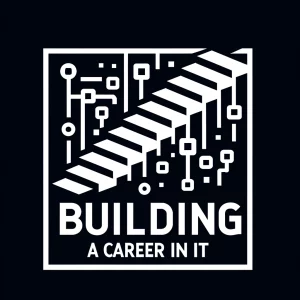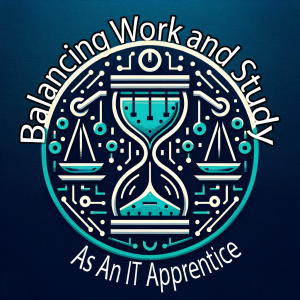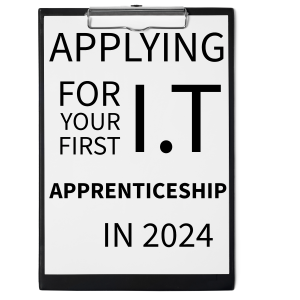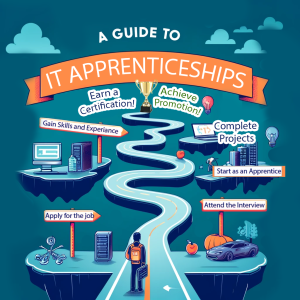Navigating the First Job Offer Post-Apprenticeship: How to Evaluate Job Offers, Negotiate Salaries, and Decide the Best Path Forward – Introduction
Unlock the secrets to successfully handling your first job offer after an IT apprenticeship. Learn how to evaluate job offers, negotiate salaries, and choose the best career path with our expert tips in 2024.
Written by Andy Naisbitt
Transitioning from an IT apprenticeship to your first full-time job is an exciting and challenging milestone. As a senior systems engineer who started my career as an IT apprentice, I vividly remember the mix of emotions that came with receiving my first job offer. The sense of accomplishment was undeniable, but so was the uncertainty about whether I was making the right choice for my career. In this post, I’ll share my experiences and offer actionable advice to help you navigate this crucial step in your professional journey.
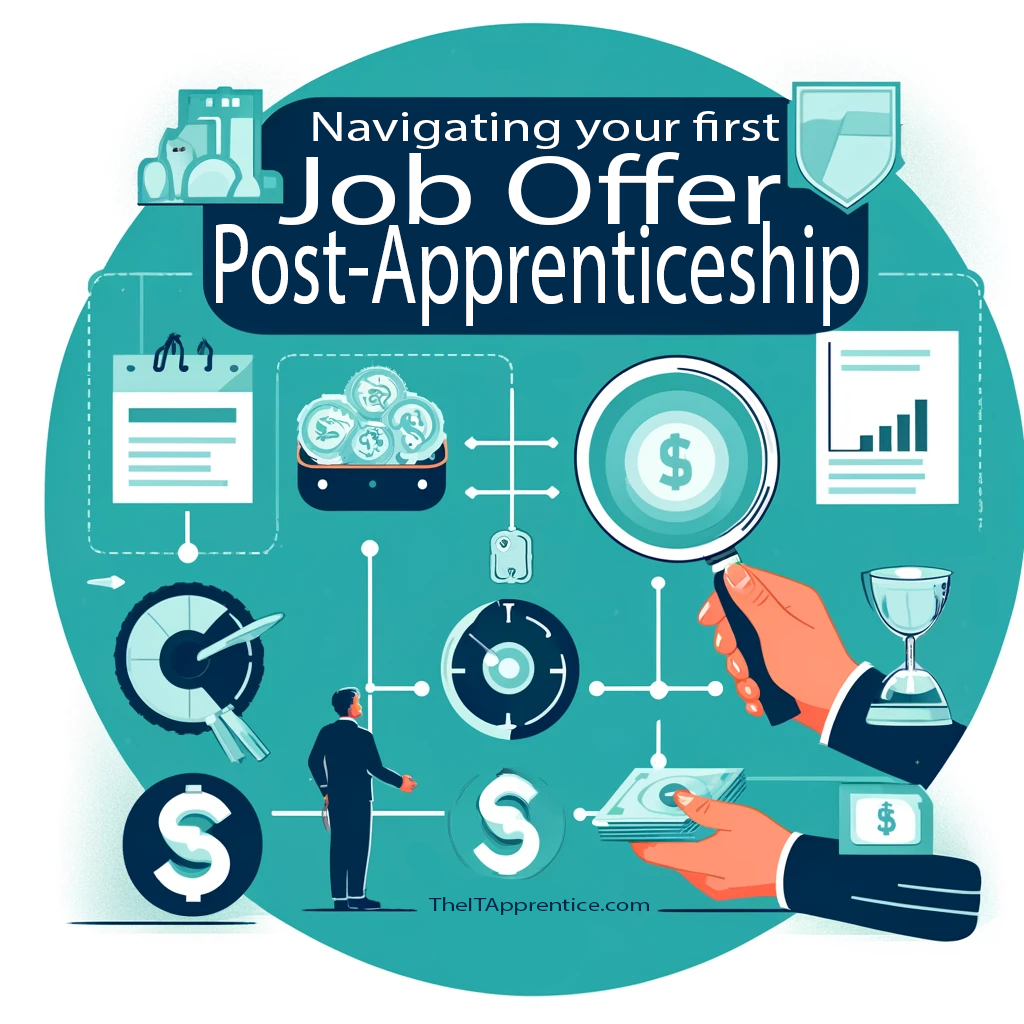
Section 1: Understanding Job Offers
When you receive your first job offer, it’s essential to look beyond the salary. Consider factors such as the company culture, opportunities for growth and learning, and the potential for long-term career progression. During my transition from an apprentice to a full-time role, I evaluated job offers based on the following criteria:
- Alignment with my career goals and aspirations
- Opportunities for skill development and continuous learning
- The company’s reputation and stability in the industry
- Work-life balance and flexibility
- The team dynamics and potential for mentorship
Remember, your first job is a stepping stone in your career, so it’s crucial to choose a role that aligns with your long-term objectives and values.
Section 2: Evaluating the Offer
To thoroughly assess a job offer, break it down into key components. Here’s a checklist I used when evaluating my first job offer post-apprenticeship:
- Job title and responsibilities
- Salary and compensation package
- Benefits (health insurance, retirement plans, paid time off)
- Company culture and values
- Career development and training opportunities
- Location and commute
- Job security and stability
- Potential for advancement and growth
Take the time to carefully consider each aspect of the offer and how it aligns with your personal and professional goals. Don’t be afraid to ask for clarification or additional information if needed.
Section 3: Negotiating Your Salary
Negotiating your salary can be daunting, especially when you’re just starting out in your career. However, it’s an essential skill to develop. When approaching salary negotiations, keep the following tips in mind:
- Research industry benchmarks and salary ranges for your role and location
- Highlight your unique skills, experiences, and achievements during the apprenticeship
- Practice your negotiation skills with a trusted mentor or friend
- Be confident and respectful in your approach
- Be prepared to justify your request with concrete examples and data
In my experience, I found that being well-prepared and confident in my value helped me secure a competitive salary. Remember, the worst that can happen is that the employer says no, but even then, you’ve gained valuable experience in advocating for yourself.
Section 4: Understanding Benefits and Perks
A comprehensive compensation package goes beyond just the salary. Pay close attention to the benefits and perks offered by the employer, as they can significantly impact your overall job satisfaction and financial well-being. Some key benefits to consider include:
- Health, dental, and vision insurance
- Retirement plans (401k, pension)
- Paid time off (vacation, sick days, personal days)
- Professional development and training opportunities
- Flexible work arrangements (remote work, flexible hours)
- Wellness programs and employee assistance programs
While these benefits may not be as tangible as a salary, they can provide long-term value and support for your personal and professional growth.
Section 5: Making the Decision
Deciding whether to accept or reject a job offer is a significant decision that should be based on careful consideration of multiple factors. When I was faced with my first job offer, I weighed the following aspects:
- Alignment with my career goals and aspirations
- Opportunities for growth and skill development
- Work-life balance and company culture
- Compensation package (salary, benefits, perks)
- Commute and location
- Gut feeling and overall excitement about the role
Looking back, I would advise my younger self to also consider the potential for mentorship and the company’s long-term stability. It’s essential to trust your instincts and make a decision that feels right for you, even if it means turning down an offer that doesn’t align with your goals.
Section 6: Planning for the Future
Once you’ve accepted your first job offer, it’s crucial to start planning for your long-term career trajectory. Here are a few key pieces of advice I wish I had known when I started:
- Set short-term and long-term career goals
- Continuously invest in your skills and knowledge
- Build a strong professional network
- Seek out mentors and sponsors within your organization
- Be proactive in seeking out new opportunities and challenges
- Regularly assess your career progress and make adjustments as needed
Remember, your first job is just the beginning of your professional journey. By staying focused on your goals, continuously learning, and being open to new opportunities, you’ll set yourself up for a successful and fulfilling career in IT.
Navigating your first job offer post-apprenticeship can be both exciting and overwhelming. By carefully evaluating the offer, negotiating your salary, understanding the benefits and perks, and making a decision that aligns with your career goals, you’ll be well-positioned to start your IT career on the right foot.
Remember, there’s no such thing as failure – every experience, whether successful or not, is an opportunity to learn and grow. Trust your instincts, be confident in your abilities, and don’t be afraid to ask for help or advice when needed.
If you’re an IT apprentice preparing to navigate your first job offer, I’d love to hear about your experiences and any questions you may have. Share your thoughts in the comments below, and let’s start a conversation about how we can support each other in this exciting new chapter of our careers.
For more insights and advice on advancing your IT career, be sure to subscribe to my blog. Together, we can learn, grow, and achieve our professional goals in this dynamic and rewarding field.
Next guides in the series |
Guide to IT Apprenticeships: Overview of different types of apprenticeships, what they entail, and which might be right for different interests and skills.
https://theitapprentice.com/blog/guide-to-it-apprenticeships/Searching for an IT Apprenticeship in 2024: How to find your next IT job as an apprentice in 2024 and use advanced techniques and methods to find them
https://theitapprentice.com/blog/searching-for-an-it-apprenticeship-in-2024/Applying for Your First IT Apprenticeship: Step-by-step application process, tips for standing out, and common mistakes to avoid.
https://theitapprentice.com/blog/applying-for-an-it-apprenticeship-in-2024/Age Is Just a Number: Addressing age-related concerns in IT apprenticeships, showcasing examples of successful apprentices from various age groups.
https://theitapprentice.com/blog/age-is-just-a-number/Building a Career from an IT Apprenticeship: How to leverage an apprenticeship for career advancement, using your career as a case study.
https://theitapprentice.com/blog/building-a-career-from-an-it-apprenticeship/Essential Skills for IT Apprentices: Key technical and soft skills that will help apprentices excel in their roles.
https://theitapprentice.com/blog/essential-skills-for-it-apprentices/What to Expect in Your First Year as an IT Apprentice: Month-by-month guide of challenges and milestones.
https://theitapprentice.com/blog/what-to-expect-in-your-first-year-as-an-it-apprentice/Balancing Work and Study as an IT Apprentice: Tips for managing time effectively, based on your personal experiences.
https://theitapprentice.com/blog/balancing-work-and-study-as-an-it-apprentice-tips-for-managing-time-effectively/- Navigating the First Job Offer Post-Apprenticeship: How to evaluate job offers, negotiate salaries, and decide the best path forward.
https://theitapprentice.com/blog/navigating-the-first-job-offer-post-apprenticeship/ - Certifications to Boost Your IT Career: Recommendations on certifications that are beneficial for apprentices, tailored to different IT paths.
https://theitapprentice.com/blog/certifications-to-boost-your-it-career-tailored-guidance-for-it-apprentices/
Join Our Community!
🌟 Get exclusive insights and the latest IT tools and scripts, straight to your inbox.
🔒 We respect your privacy. Unsubscribe at any time.


